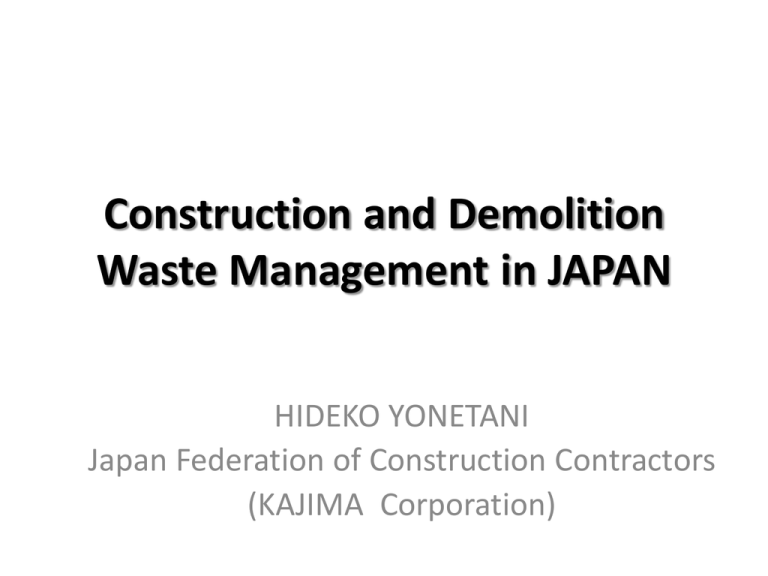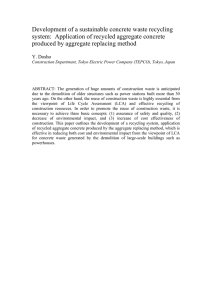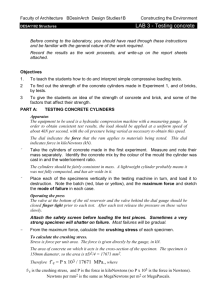Construction Waste Treatment in JAPAN
advertisement

Construction and Demolition Waste Management in JAPAN HIDEKO YONETANI Japan Federation of Construction Contractors (KAJIMA Corporation) Contents 1. 3R Activities in the Construction Industry of Japan 2. Demolition Waste Management 3. Eradication of Illegal Dumping 1. 3R Activities in the Construction Industry of Japan Construction Waste Generation Waste Generation of All Industries in Japan 380 million tons/year Chemical industry 13.37 million… Others 54 million 14% Construction 75.4 million 20% Steel industry 28.25 million 7% Pulp and Paper 29.9 million 8% Agriculture 84.71 million 22% Energy (electricity, gas, heating supply, water supply) 95.58 million 25% Source: The Ministry of the Environment, 2011 Item (Total generation) Recycling Rate Recycling rate Reduction rate Waste concrete (3,092t) Final disposal rate 99% 1% 0% Waste asphalt (2,577t) 99% 1% 0% Sludge (657t) Mixed waste (80t) Waste wood chips (500t) Others (164t) 69% 16% 57% 1% 15% 42% 89% 84% 5% 6% 7% 9% Source : Census of Construction waste, 2012 Reduce Precast concrete Precut autoclaved Lightweight aerated Concrete (ALC) Non-packaged air-conditioning duct Construction Waste Treatment Waste Concrete Crushing Recycled Concrete Aggregate (RCA) Waste Asphalt Crushing/ Melting Reclaimed Asphalt Pavement (RAP) Waste Wood Crushing Particle Board/ Power Generation Metal Crushing/ Melting Recovered Metal Cardboard Melting Cardboard Electric Wire Melting/ Compression Crushing/ Separation Gypsum Board Crushing/ Separation Gypsum Board ALC Crushing ALC Mixed Waste Crushing/ Separation Recycled/ Landfilled Waste Plastic RPF Copper Recycling by Treatment Operators Recycled concrete aggregates Recovered copper of electric wires Particleboard made of waste wood RPF derived from waste plastic containers Recycling by Manufacturers Gypsum board ALC Glass wool On-site Waste Sorting Mixed Waste Processing ・Mixed waste is separated manually and mechanically at the waste processing facility into recyclable/non-recyclable waste. ・Non-recyclable waste is to be disposed in landfills. Reduction of Mixed Wastes Mixed waste generation per total floor area(kg/m2) Source: Japan Federation of Construction Contractors (JFCC), 2011 Images of Sorting Effect Small-Scale Site (10,000m2 or below) Cost (\/m2) Large-Scale Site (50,000m2 and over) Cost (\/m2) 100% 100% 62% 70% Mixed waste (kg/m2) 10 categories 100% Mixed waste (kg/m2) 18 categories 100% 25% 10% 2.Demolition Waste Management Hazardous Materials from Demolition ・Asbestos-containing materials ・PCB containing equipment ・Freon containing appliances ・Mercury in fluorescent lamps etc. Assessment is essential for determination and proper treatment of hazardous materials. Reference Materials for Hazardous Wastes “Appropriate Handling of Hazardous Materials in Demolition”) Published by the Ministry of Land, Infrastructure and Transport and Tourism (MLIT) Reference Materials for Asbestos “Seeing Asbestos with Your Own Eyes”) Published by the Ministry of Land, Infrastructure and Transport and Tourism (MLIT) Checklist for Assessment 3.For Eradication of Illegal Dumping Around Illegal Dumping Site ・More than 800 thousand ㎥ of wastes were dumped on a mountain by a treatment operator over 10 years. ・10 billion yen was used for restoration and recovery of the site but only a part of waste has been removed. Waste Management in Kajima Reinforced management on selection of the treatment operators (intermediate treatment and final disposal); ・The operators must be limited to the qualified operators that the management division has approved. ・The management division of each branch visits the facilities of the prospective operators and examines their capabilities of waste treatment. Responsibilities of Waste Generator ① Select trustworthy operator to commission waste management ② Pay appropriate waste processing costs ③ Take strong measures against hazardous demolition and renovation waste ④ Control and reduce waste generation ⑤ Sort the waste and maximize recycling Thank you very much for your kind attention.



